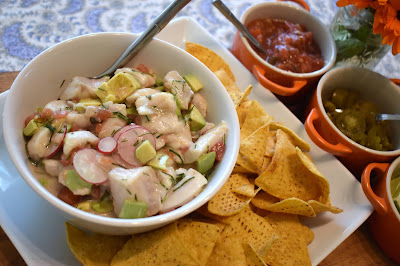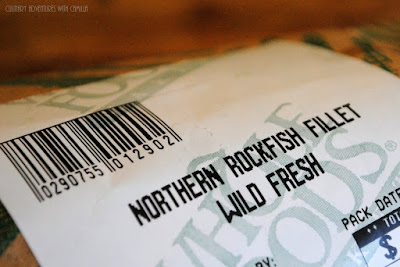 Claudia of Honey from Rock is hosting our bi-monthly reading group Cook the Books. And, if you'd like to join the fun, the posts aren't due till the end of March, so you still have time. You can read her announcement here. She has asked us to read Where I Come From: Life Lessons from a Latino Chef by Aarón Sánchez* which is the book pick for February and March 2021.
Claudia of Honey from Rock is hosting our bi-monthly reading group Cook the Books. And, if you'd like to join the fun, the posts aren't due till the end of March, so you still have time. You can read her announcement here. She has asked us to read Where I Come From: Life Lessons from a Latino Chef by Aarón Sánchez* which is the book pick for February and March 2021.
I have had this on my shelf for a few months and just kept pushing off starting it until I read some other books. When I had a lull...and realized that February was almost gone...I picked it up. And it was a breeze to read and a completely delight!
I know that I have seen Aarón Sánchez on television when we've stayed in hotels and watched the Food Network. Maybe Chopped. Maybe MasterChef or IronChef. But he never struck me as a television personality that I was compelled to read more about or learn his back story. So, I'm glad that Claudia picked this memoir because his story was absolutely wonderful.
From his parents' divorce and his move to New York City with twin brother and his mother - herself a pioneering Mexican chef - to dropping out of culinary school after a year to opening and closing restaurants of his own, the candor with which Sánchez tells his story is both compelling and inspiring. He writes with reflection about his failed marriage, depression, and even the MeToo movement in the restaurant industry. But it is his dedication to his craft, especially shining the spotlight on Latino cuisine and traditions, that created a book that I couldn't put down.
Here's how he described Mexican cuisine, "Always the food. Rusty, dried guajillo peppers. Verdant sprigs of curled cilantro. Flavors that take days to develop, layered with wildly complex blends of spices and ingredients, techniques that take years to master, so that every dish pops and dances on the palate. There is nothing about the food of Mexico that is dull or muted." And "In Mexico, cooking for someone is the ultimate gesture of love, so what better way to draw your brother back from the dead than with his favorite earthly delights?"
And he writes about his identity as a Mexican-American chef, "Being bicultural always presents that challenge; you’re never quite American enough north of the border, and never exactly Mexican enough on the other side." About culinary authenticity, he muses, "I think what I’ve learned in my time in Mexico is that in some ways, the 'authentic' Mexican way of doing things means doing it your own way. With the ingredients and techniques that come from your own heritage and your own surroundings. We wouldn’t expect a homogenous product from Puebla to Veracruz; adaptation based on geography and personal experience is making food in the true Mexican spirit."
After I finished the book I started streaming The Taco Chronicles on Netflix. It's not his show, granted, but there was something about his book that inspired me to watching several episodes that focused on regionally relevant and traditional tacos from all over Mexico. Word of warning: don't read this book while you're hungry. Seriously.
Clearly there was a lot of food inspiration in this book! And I will be trying several of the recipes he included in his book.
But I was inspired into the kitchen from this passage about his menu at Patria: "a dish called 'Fire & Ice'—a coconut ceviche with tuna and ginger and tons of chile, served out of a coconut shell over ice, surrounded by a flurry of snow-white coconut shavings. Or ceviche negra, octopus and scallops served in an emulsion of black-as-night squid ink. Golden arepas were made fresh, one side with yellow and the other with white corn, stuffed with a satiny black bean puree and farmers cheese, served with blistered heirloom tomatoes and finished with a fire-branded star. The stuff coming out of that kitchen was creative and beautiful and completely unique. We had a dessert burro made to look like a cigar; we called it the 'Smokeless Cuban.' It was stuffed with dulce de leche and chocolate mousse, rolled in tons of cocoa powder and served with matches made from spun sugar and a whipped coffee custard—even a cigar band with the restaurant’s name. Every night I went to work so proud to be putting my small stamp on each of those dishes."
Ceviche is a simple dish of seafood "cooked" by the acid in limes. It's so easy, but it requires incredibly fresh ingredients. I usually ask my fish monger which is the best choice for ceviche that day. That day he offered me wild-caught, local rockfish. Perfect!
- 1 to 1-1/2 pounds, rockfish, cut into 1" pieces
- 6-8 fresh limes, juiced plus lime wedges for serving
- 1/4 cup fresh salsa plus more for serving
- 1 to 2 organic avocados, cubed
- 2 radishes, rinsed and thinly sliced
- 2 Tablespoons fresh herbs, chopped (traditional would be cilantro, but I had dill from our garden)
- 6 Tablespoons coconut milk or coconut cream
- freshly ground salt
- freshly ground pepper
- tortilla chips, for serving
- candied jalapeños (my recipe here), for serving (that's the 'fire' part for my dish!)
Place the raw seafood pieces in a glass dish and cover them
with freshly squeezed lime juice. The seafood should be completely covered by juice.
Cover the dish and place it in the refrigerator. Let the seafood marinate or "cook" in the lime juice for at least 4 hours. Once the seafood is "cooked" in the juices, drain the lime juice, but reserve 1 to 2 Tablespoons of the juice.
Stir in the salsa, avocado, radishes, herbs, and coconut milk. Stir in the reserved lime juice. Season to taste with salt and pepper.
Click to see what everyone else read in February 2021: here.










That fire and ice sounded wonderful to me as well, however I would be the only taker for it in this household. I have always liked Aaron and I loved that my mind read his words using his voice.
ReplyDeleteMore ceviche for you, then! Thanks for stopping by.
DeleteI marked the passage about Mexican cuisine as well. Love this colorful dish!
ReplyDeleteI have absolutely got to make this dish, what a fabulous concoction! Will probably use ahi tuna though, which we get a lot of fresh here.
ReplyDeleteYour ceviche looks fabulous, Cam. Gorgeous presentation :)
ReplyDelete